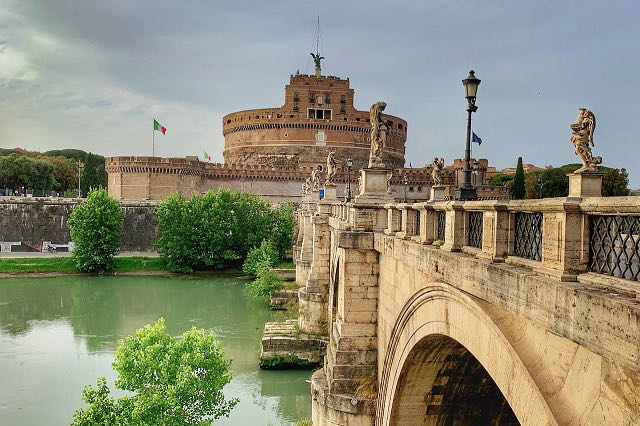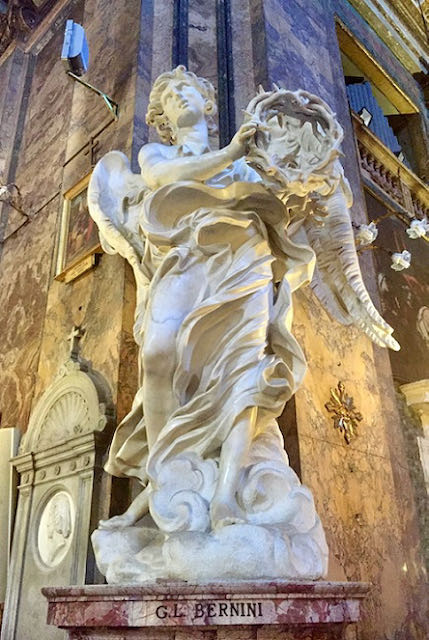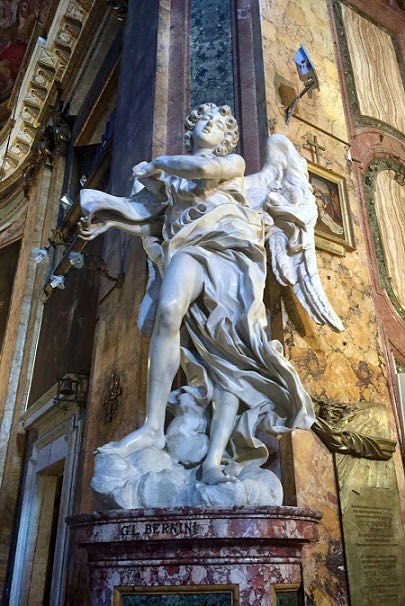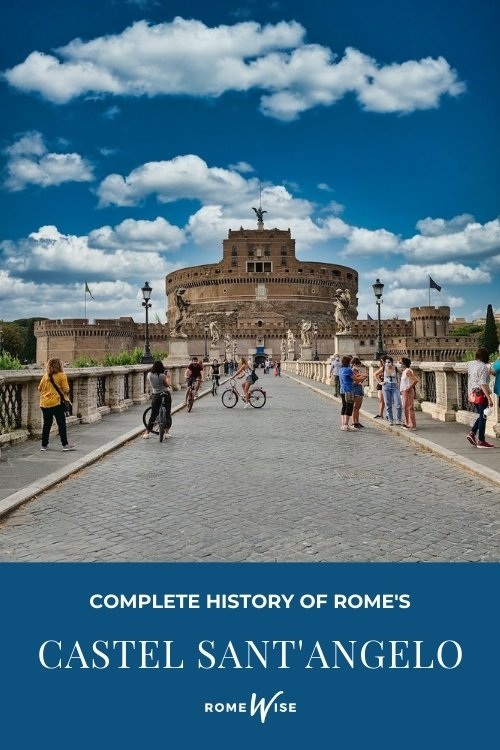- Sign up & get a FREE ebook Subscribe NOW!
- Romewise Home Page
- Castel Sant Angelo Rome
Castel Sant Angelo Rome - a fascinating history of Rome's castle on the Tiber
Have you visited Castel Sant Angelo Rome?
From the outside, it may look like "just a castle", but it's actually one of the most important monuments in the Eternal City.
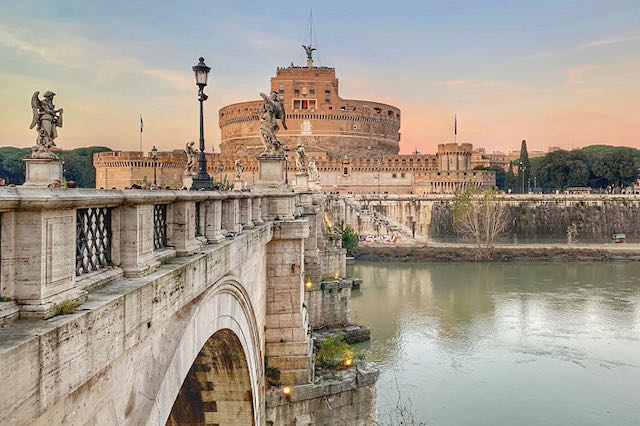 Castel Sant'Angelo is a must-see in Rome, especially if you want to understand Rome's 2,000-year-old history all in one place.
Castel Sant'Angelo is a must-see in Rome, especially if you want to understand Rome's 2,000-year-old history all in one place.Castel Sant'Angelo is not just a castle.
It's a tomb, a fortress, papal party palace, the site of horrific executions, and much more.
Castel Sant Angelo - one of the most complex histories in Rome
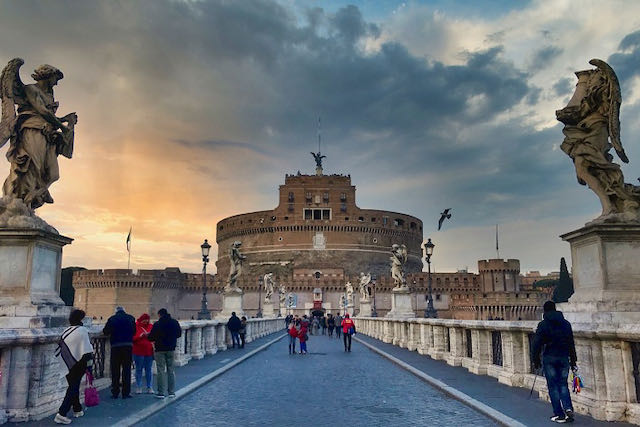 Castel Sant'Angelo is not just a beautiful monument. It's one of the best places to visit to understand Rome's 2,000-year-old history.
Castel Sant'Angelo is not just a beautiful monument. It's one of the best places to visit to understand Rome's 2,000-year-old history.While you can easily spot Castel Sant'Angelo from many vantage points in the city, a bottom to top visit to this monument will give you, like no other site in Rome, a real taste of Rome's history, good and bad, over the past 2 millennia.
On this page, we’ll go over:
- In the beginning - Mausoleum of Emperor Hadrian
- How a tomb became a fortress
- The site of a miracle and why there is an angel on top of Castel Sant'Angelo
- How and why Castel Sant'Angelo became a papal hideout
- Castel Sant'Angelo as prison - some of its most famous prisoners
- Castel Sant’Angelo plan and architecture
- The Angel Bridge – Ponte Sant’Angelo
Castel Sant Angelo Rome - History and Facts
The history of Castel Sant’Angelo is pretty complex and also really fascinating.
The monument has changed names, personalities, architecture, and uses many times over the nearly 2,000 years of its existence.
Hadrian’s Mausoleum
If you visit the Ara Pacis, you will see a large, round, ancient monument in front of it.
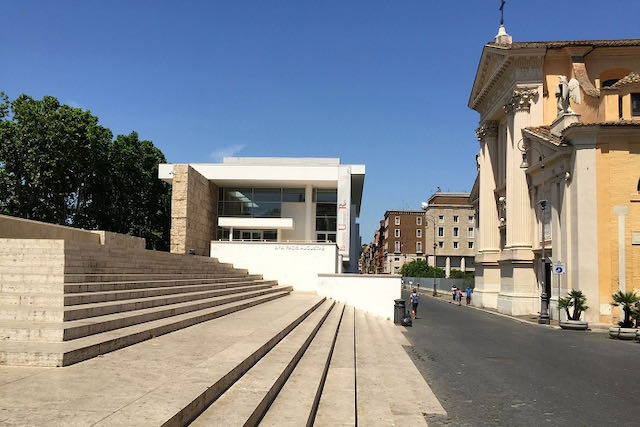 Ara Pacis Augustae, or the altar of peace. Emperor Augustus wanted to celebrate peace after his conquests in the Mediterranean, leaving this magnificent work of art to posterity.
Ara Pacis Augustae, or the altar of peace. Emperor Augustus wanted to celebrate peace after his conquests in the Mediterranean, leaving this magnificent work of art to posterity.That monument is the mausoleum of Rome’s first emperor, Octavian Augustus (older than the Colosseum!) and is once again open to visitors (on guided tours only) after many years of restoration.
(The Mausoleum of Augustus did reopen it briefly but closed it to continue renovations. It should open sometime in summer 2023. Stay tuned!)
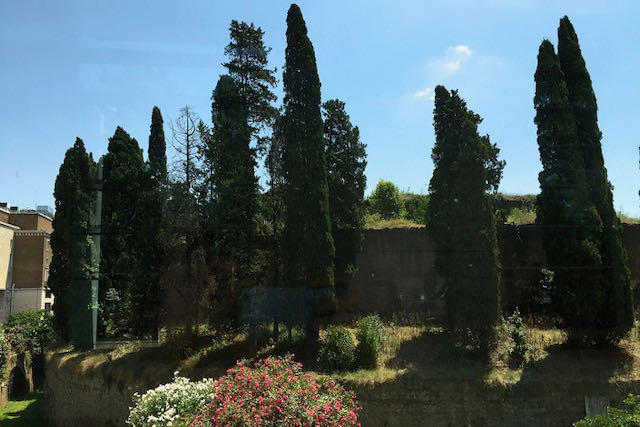 From the window of the Ara Pacis, you can see Augustus' mausoleum.
From the window of the Ara Pacis, you can see Augustus' mausoleum.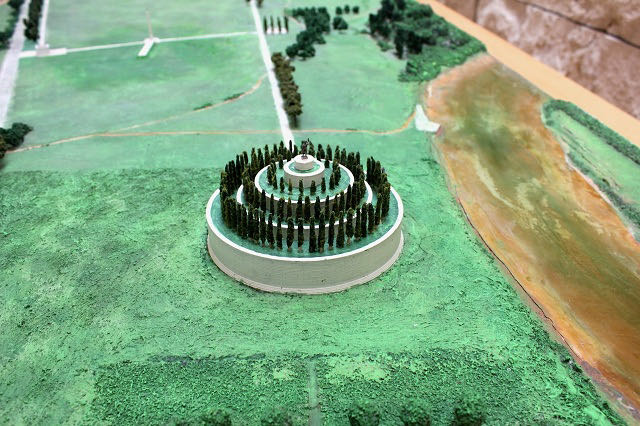 Inside the Ara Pacis you can see this small model of Augustus' mausoleum.
Inside the Ara Pacis you can see this small model of Augustus' mausoleum.Emperor Hadrian came along about a hundred years later.
He saw himself as the next Augustus.
Like Augustus, he envisioned grand building works for Rome (you may know some of his accomplishments, such as the Pantheon, his wall in what is today England, and his palace in Tivoli, among others.)
One of the things that inspired Hadrian was Augustus’ mausoleum.
If it was good enough for Augustus, it was good enough for Hadrian.
So, he had one built for himself on the Tiber river.
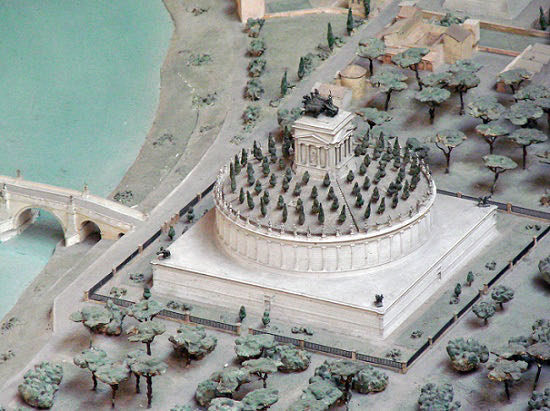 Model of Hadrian's Mausoleum in the no-longer-open Museum of Roman Civilization. Photo credit - Jean-Pierre Dalbéram Paris, France - Wikimedia Commons.
Model of Hadrian's Mausoleum in the no-longer-open Museum of Roman Civilization. Photo credit - Jean-Pierre Dalbéram Paris, France - Wikimedia Commons.The Hadrianeum or Sepulcrum Antoninorum, (which means Hadrian’s Mausoleum) as it would be called at first, was built between 135 – 139 CE.
It was completed under Hadrian’s successor, Antoninus Pius one year after Hadrian’s death.
Today Romans often refer to Castel Sant'Angelo by one of its original nicknames, “il Mole Adriano”, or Hadrian’s mole.
A mole (pronounced mò-ley) is a massive edifice.
Hadrian was cremated and buried there once it was completed.
Subsequent emperors were also buried there up to and including, in 217, Emperor Caracalla (he of the baths).
Fortress as part of the Aurelian Walls
As Rome’s fortunes changed, so did Hadrian’s mausoleum.
Towards the end of the 3rd century, the mighty Roman Empire began its long slow decay.
In 271 CE, Emperor Aurelian had defensive walls built around the city.
These walls encompassed Hadrian’s Mausoleum.
The walls today constitute Rome’s largest ruin - and you can visit them!
In 401, Hadrian’s tomb, as part of the Aurelian Walls, was converted into a military fortress.
In 403, the Western Roman Emperor Honorius expanded and modified the Aurelian walls, nearly doubling them in height.
The mausoleum began to take on a new identity.
The word castellum was starting to be used to describe it.
Despite the walls’ new height and thickness, Rome continued to suffer near-constant attacks.
Tribes from the north, such as Barbarians, Goths, Visigoths, and others continuously sacked Rome.
In one brutal raid by the Visigoth hordes led by Alaric in 410, the urns and ashes from the fortress were broken and scattered.
Bye-bye priceless relics from Ancient Rome.
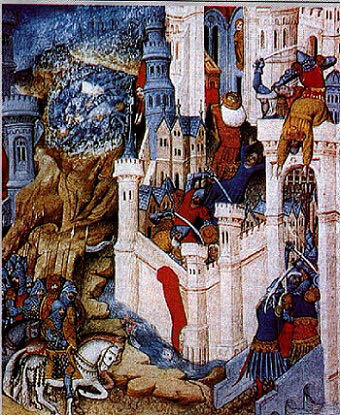 An anachronistic rendering of the 410 attack on Rome by Alaric. Wikimedia Commons, public domain.
An anachronistic rendering of the 410 attack on Rome by Alaric. Wikimedia Commons, public domain.EXCELLENT BOOK!
Looking to brush up on your Roman history?
I love this book by Matthew Kneale.
The author skillfully recounts the history of Rome in 7 sackings.
It's well-written and an easy and fun read.
When Rome was attacked by Goths in 537, the Romans withdrew to the fortress and threw many of the original bronze and stone decorative statues at the raiders in an attempt to defend themselves.
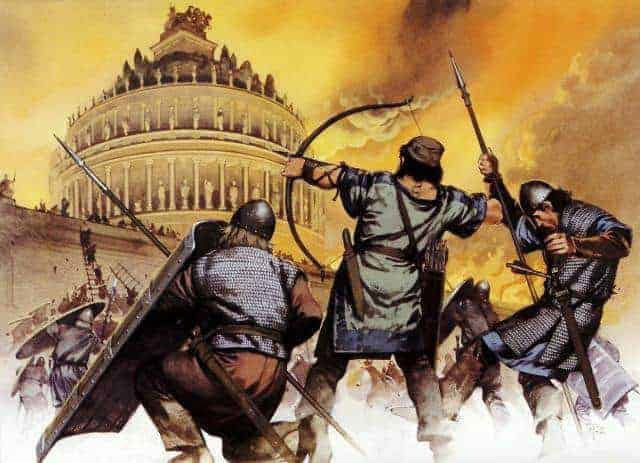 The Ostrogoth attack on Rome in 537 resulted in a huge destruction of Hadrian's tomb.
The Ostrogoth attack on Rome in 537 resulted in a huge destruction of Hadrian's tomb.Can you just picture this?
I cringe at what was lost.
Anyway, it was all to no avail.
Rome was mercilessly razed.
Thankfully, one thing from Ancient Rome, besides the building itself, survived these raids.
The porphyry marble lid of Hadrian’s tomb was somehow preserved and placed on top of the tomb of Otto II in the grottoes of St. Peter’s Basilica.
It eventually made its way to becoming the base of a baptismal font, which can be seen in the first chapel on the left-hand side of Saint Peter’s Basilica.
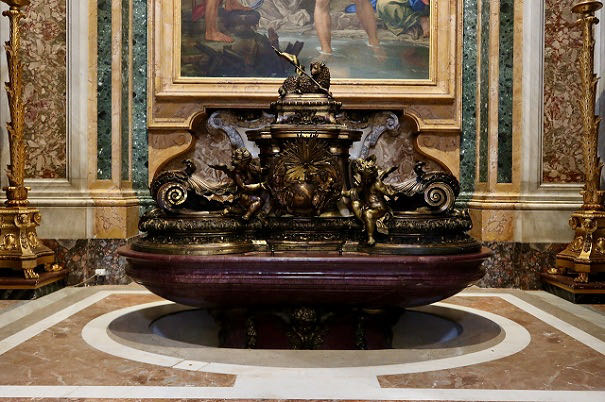 This baptismal font in Saint Peter's basilica was probably once the lid of Hadrian's urn. One rare surviving element of Hadrian's mausoleum, today Castel Sant Angelo Rome.
This baptismal font in Saint Peter's basilica was probably once the lid of Hadrian's urn. One rare surviving element of Hadrian's mausoleum, today Castel Sant Angelo Rome.Site of a miracle
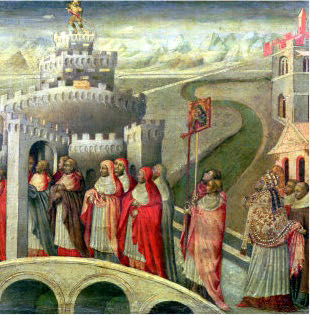 Procession of Pope Gregory.
the Archangel Michael appears in the act of sheathing the
fire sword.
Procession of Pope Gregory.
the Archangel Michael appears in the act of sheathing the
fire sword.Why is this monument called Castel Sant’Angelo – Castle of the Holy Angel?
In 590, Rome was suffering from a devastating plague that had been raging through the region for about 50 years.
Pope Gregory I led a penitential procession to drive away the infestation.
The procession passed right by the castle.
And in that moment, the pope had a vision of the Archangel Michael above the castle, sheathing his sword.
Coincidentally, after this event, the plague ended.
Naturally the Pope took it as a sign that his vision had divine meaning.
The fortress was now referred to as Castel Sant’Angelo – Castle of the Holy Angel.
If you visit the Capitoline Museums, you can see what are said to be the footprints of the Archangel Michael when he came to earth.
The Angel on Top
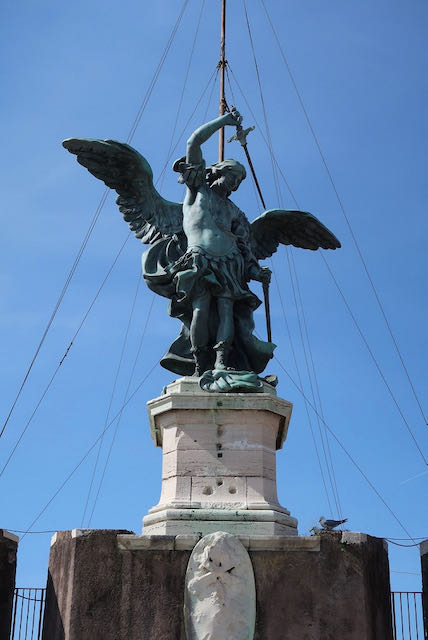 The bronze angel on top of Castel Sant Angelo Rome was made in 1753 by Flemish sculptor Pieter Van Verschaffelt.
The bronze angel on top of Castel Sant Angelo Rome was made in 1753 by Flemish sculptor Pieter Van Verschaffelt.Of course a castle named for an angel should have an angel adorning its roof.
There have been 6 angels up there:
- The first version, placed there in the 13th century, was made of wood and pretty quickly disintegrated.
- It was replaced by a marble angel, which was destroyed in 1379 during yet another attack on Rome.
- Another marble angel with bronze wings was placed on top. In 1497 it was destroyed by a bolt of lightning.
- The next angel was made of bronze. During the 1527 Sack of Rome, this angel was melted to make cannons.
- In 1536, Raffaello da Montelupo, apprentice to Michelangelo, made a marble angel with bronze wings. This angel is still intact and you can see it inside the castle.
- In 1753, Flemish sculptor Pieter Van Verschaffelt made the bronze angel you see today.
Ready to plan your trip?
Book your train
Planning to travel between cities in Italy and other parts of Europe?
Use Trainline to see all the different options available across the different rail companies.
Find your hotel
Find your perfect place to stay in Rome.
Use Booking.com to choose between hotels, guesthouses, and self-catering apartments in neighborhoods throughout the Eternal City.
Buy your TurboPass
Purchase the convenient Turbopass and visit all of Rome's top attractions including the Colosseum, Pantheon, and Vatican.
With one handy pass, it's all included.
Castel Sant Angelo Rome - Medieval tumult and new role as papal fortress
Once it ceased being an imperial burial place, Castel Sant’Angelo played the part of lone or at least main, fortress in Rome.
In the Middle Ages, popes often sparred with powerful noble families, mostly the Crescenzi and the Orsini, for control of it.
In the 9th century, Pope Leo IV linked the castle to the Vatican walls.
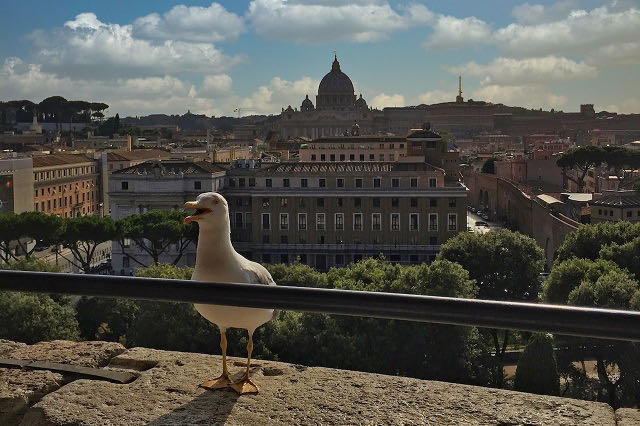 In this view from the roof of Castel Sant Angelo Rome towards Saint Peters' Basilica, you can see on the right-hand side the original Leonine wall which later became the Passetto di Borgo - an above-ground corridor that popes could use to escape the Vatican in times of trouble.
In this view from the roof of Castel Sant Angelo Rome towards Saint Peters' Basilica, you can see on the right-hand side the original Leonine wall which later became the Passetto di Borgo - an above-ground corridor that popes could use to escape the Vatican in times of trouble.In 1277 Pope Nicholas III (Orsini) moved the Apostolic See there, due to its location near St. Peter’s Basilica.
He then renovated the part of the existing Leonine wall that linked the castle to St. Peter’s Basilica.
He also covered a portion of the top of it to create the Passetto di Borgo (which you can walk along today if you take the Castel Sant’Angelo Secret Tour.)
The 800-meter long (2,600 feet) passageway allowed the Pope to escape and hide in the fortified castle if Rome or the Vatican came under attack, which was a pretty common event back then.
Passetto di Borgo - Escape route for the popes
The passageway of Castel Sant Angelo Rome was used for this purpose twice:
In 1494 Pope Alexander VI (Borgia) escaped during the invasion by Charles VIII.
More famously, during the infamous and horrific 1527 Sack of Rome by troops loyal to Holy Roman Emperor Charles V, Pope Clement VII (Medici) escaped and hid out in the Castle for months.
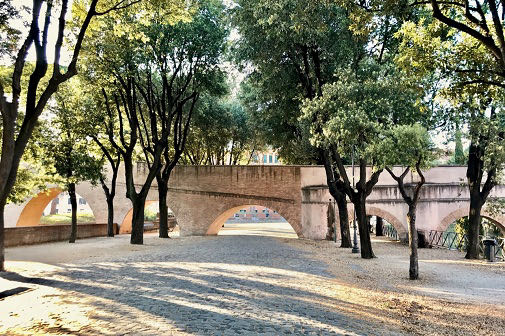 When you visit the park that surrounds Castel Sant Angelo Rome, you can see where the Passetto di Borgo starts.
When you visit the park that surrounds Castel Sant Angelo Rome, you can see where the Passetto di Borgo starts.In 1367, to mark the end the Avignon papacy and return of the Holy See to Rome, Pope Urban V received the keys to Castel Sant’Angelo.
It was this moment that sealed the building’s destiny as a papal stronghold.
From then on, many popes had a hand in altering the structure and function of the castle.
Pope Boniface IX built a new internal ramp in the late 14th century.
Pope Nicholas V built small towers on the outer walls in the early 15th century.
Castel Sant Angelo Rome in the Renaissance
Pope Alexander VI (Borgia) was one of the popes who oversaw a majority of works on the castle.
In the late 15th century, he had bastions built on each corner, created warehouses to store supplies, and adorned many rooms as sumptuous apartments, painted by the foremost artists of the day.
In 1514 Pope Leo X (Medici) built a chapel of Saints Cosma e Damiano, the twin Greek saints who were protectors of the Medici.
The pope had Michelangelo build a small outer aedicule (shrine) as part of the chapel.
Raffaello da Montelupo, who worked for Michelangelo, made a Madonna for the chapel.
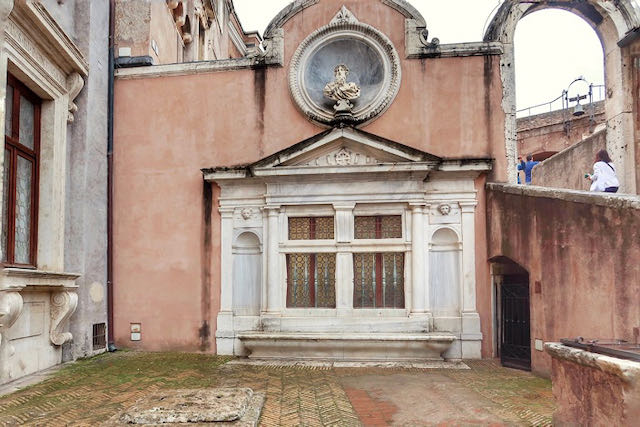 When you visit Castel Sant Angelo Rome, you can admire this small outer aedicule of Pope Leo X's chapel, designed by Michelangelo.
When you visit Castel Sant Angelo Rome, you can admire this small outer aedicule of Pope Leo X's chapel, designed by Michelangelo.In 1536 the same artist, Montelupo, created a marble statue of the Archangel Michael to be placed on top, to replace the previous bronze statue that had been melted down to make weapons during the 1527 Sack of Rome.
It’s quite interesting to see the two different styles of these most recent angels.
The one designed by Raffaello da Montelupo shows the influence of working alongside Michelangelo on Pope Julius’ tomb, where the warrior pope is seen resting and at peace.
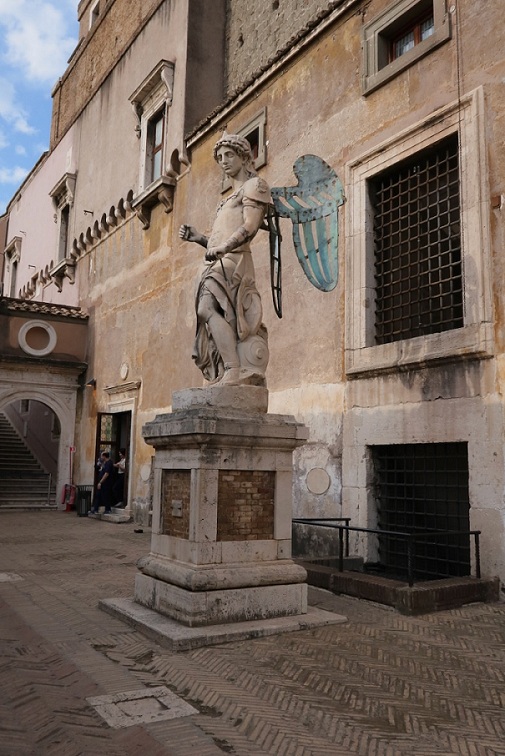 Marble agnel with bronze wings by Raffaello di Montelupo in 1536.
Marble agnel with bronze wings by Raffaello di Montelupo in 1536.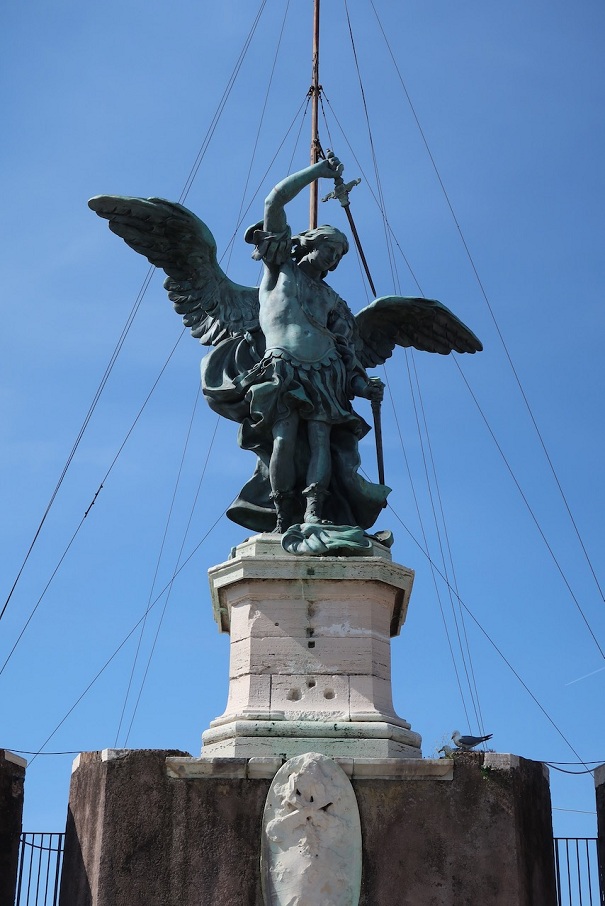 The bronze angel made by Flemish sculptor Pieter Van Verschaffelt in 1753.
The bronze angel made by Flemish sculptor Pieter Van Verschaffelt in 1753.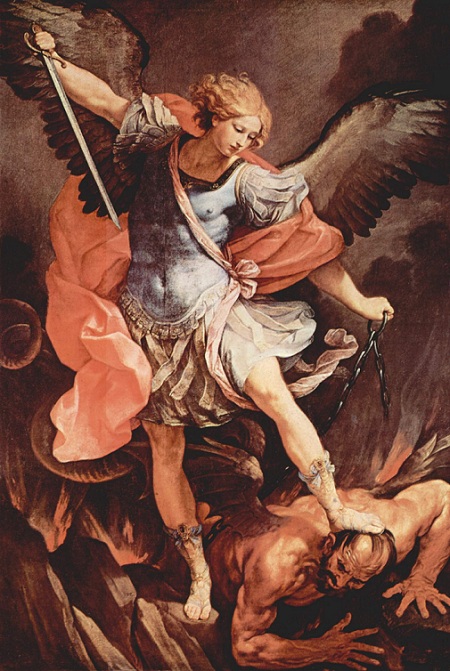 The Archangel Michael defeating Satan by Guido Reni. 1635.
The Archangel Michael defeating Satan by Guido Reni. 1635.In contrast, the angel now on top of the castle is much more dynamic and dramatic.
Influenced by a famous painting by Guido Reni that you can see in the church of the Cappuccini on via Veneto, the Flemish angel seems to be almost leaping upwards as he sheaths his sword.
The perfect 3-day itinerary in Rome
Trying to figure out how to organize your visit to Rome? I've got the perfect 3-day itinerary for first-time visitors (or those who have not been here in a while.) It works for a 2.5 day visit as well.
In my 3-day itinerary, you'll see all the major must-see Rome attractions like the Vatican, Colosseum, Trevi Fountain, Pantheon, Piazza Navona, Spanish Steps, and much more.
And if you have more time, or want suggestions for extra/other things to do, you'll find that there too.
Visit my page with the best 3-day itinerary in Rome for first-timers.
Castel Sant Angelo Rome - A papal party palace
Pope Alexander VI, who had once escaped to the castle in fear for his life, actually enjoyed staying there.
He turned some of the rooms into his private party palace, complete with stunning art by the best artists of the day.
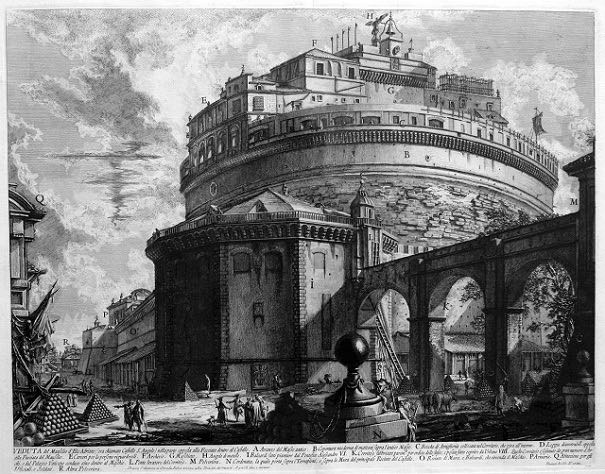 An 18th-century engraving by Piranesi of modifications to Castel Sant Angelo Rome under Pope Alexander VI (Borgia).
An 18th-century engraving by Piranesi of modifications to Castel Sant Angelo Rome under Pope Alexander VI (Borgia).The Borgia pope’s coat of arms used to adorn the outer wall of the castle, but these were mostly destroyed by French troops in the battle to unify Italy in the 19th century.
You can, however, see intact coat of arms inside the castle.
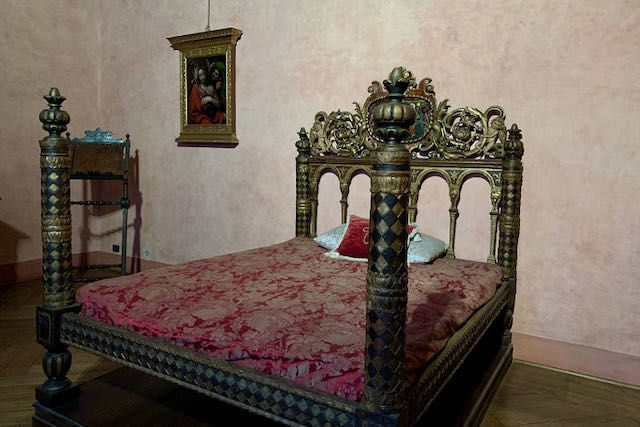 A bedroom fit for a pope inside Castel Sant Angelo Rome.
A bedroom fit for a pope inside Castel Sant Angelo Rome.In 1542, Pope Paul III (Farnese) embellished the papal apartments even further, so he and subsequent popes could hang out in style.
Some of the Renaissance work has been lost, but much remains and it’s absolutely stunning.
Another famous papal palace can be found just outside Rome at Castel Gandolfo.
Site of a gruesome prison and executions
Castel Sant Angelo Rome was used as a prison almost from the time it ceased being a mausoleum.
Prisoners were held there before their executions.
Sometimes they were simply left to starve to death (similar to the much more ancient Mamertine Prison.)
Supposedly, Pope Alexander VI held lavish parties right over the dungeons where the condemned were held.
Executions were sometimes held in the courtyard.
But they were also held on a platform in front of the castle for effect.
People who were held prisoner and executed included popes in the Middle Ages, but also nobles, artists, and philosophers.
Some of the most famous prisoners include Caravaggio, Giordano Bruno, Beatrice Cenci, Benvenuto Cellini, and “il Cagliostro.” Cellini, Caravaggio, and il Cagliostro survived to tell the tale.
Most others were much less fortunate.
Giordano Bruno
Giordano Bruno was a Dominican friar and philosopher.
A contemporary of Galileo Galilei, Bruno is famed for his ideas that the earth revolved around the sun and that stars might be other solar systems with their own plants, a theory called cosmic pluralism.
He embraced the nascent Copernican model.
Bruno also posited that the universe was infinite and disagreed that the earth was at the center.
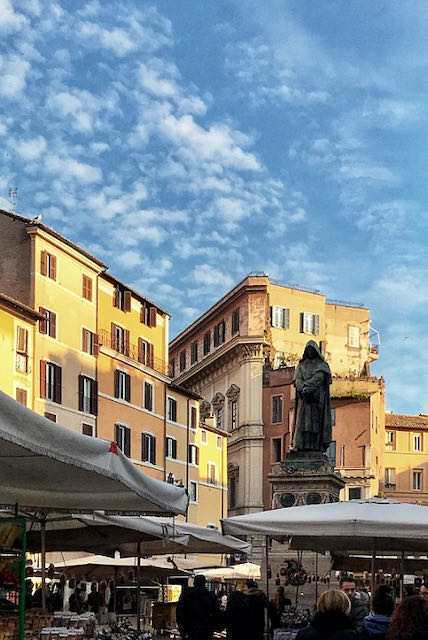 View of Campo De Fiori with the statue of the philosopher Giordano Bruno
View of Campo De Fiori with the statue of the philosopher Giordano Bruno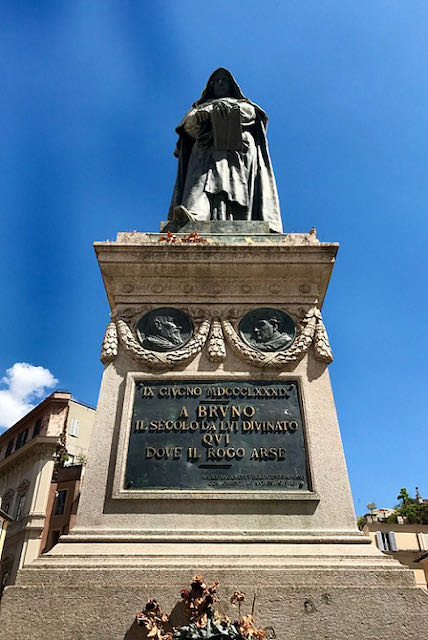 This statue celebrates the place where the philosopher Giordano Bruno, accused of heresy, was condemned to the stake by the Court of the Inquisition, after a very long process that lasted 7 years.
This statue celebrates the place where the philosopher Giordano Bruno, accused of heresy, was condemned to the stake by the Court of the Inquisition, after a very long process that lasted 7 years.During the Roman Inquisition, Bruno was charged with heresy.
In 1593 he was imprisoned in Castel Sant Angelo Rome and remained there until his horrific execution in February, 1600 in Campo dei Fiori.
His crimes were not actually about his cosmic theories, but rather his ideas about the divinity of Christ, reincarnation, and other unfavorable views.
In January 1600 he was found guilty.
He was burned at the stake, naked and upside-down, in the center of Campo dei Fiori.
His ashes were thrown into the Tiber river.
Giordano Bruno remains to this day a martyr for science and free thought.
He was eventually exonerated, and a commemorative statue of him was placed in Campo dei Fiori, with Bruno's gazed fixed towards the Vatican across the river.
You can read more about the life of Giordano Bruno here.
Beatrice Cenci
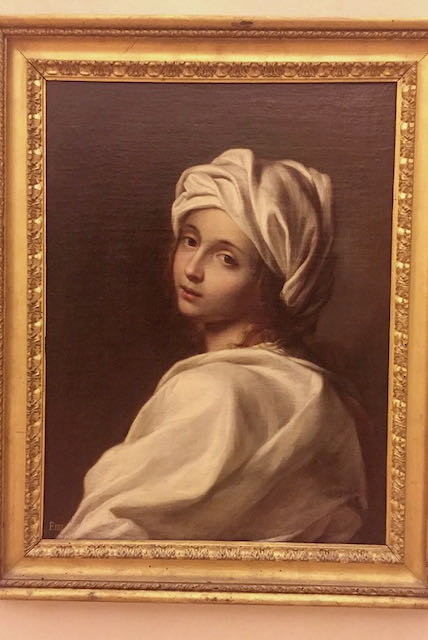 Beatrice Cenci - Guido Reni, Palazzo Barberini
Beatrice Cenci - Guido Reni, Palazzo BarberiniThe tragic story of Beatrice Cenci makes me cringe every time I think about it.
Beatrice came from a noble family.
Her father was a violent brute, beating his family members and supposedly raping Beatrice several times over.
All of Rome knew what he was, but he never had to answer for his crimes due to his wealth and status.
Beatrice, her stepmother, brother, and a servant conspired to murder Francesco Cenci.
And while all of Rome knew about this, too, nobody wanted to see the family suffer for their crime.
Unfortunately, the pope felt differently (let’s remember that when a noble family died intestate, the wealth came to the Church.)
The servant was tortured and killed without revealing anything.
But Beatrice, her stepmother, and her older brother were tried and sentenced to death.
They were executed in front of Castel Sant Angelo Rome.
The youngest brother was forced to watch these executions.
Caravaggio was present and it’s likely he used the murder of Beatrice, who was beheaded, as inspiration for his painting of Judith beheading Holofernes.
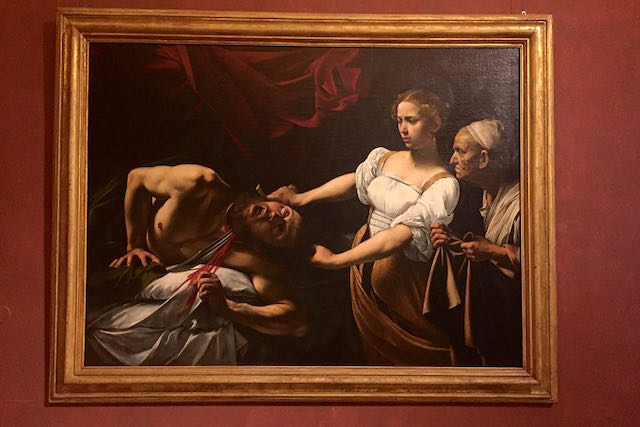 Judith beheading Holofernes by Caravaggio - Palazzo Barberini, Rome.
Judith beheading Holofernes by Caravaggio - Palazzo Barberini, Rome.If you visit the Jewish Ghetto, you can see the loggia of Palazzo Cenci.
Along via Giulia, where Beatrice was held before being taken to the execution scaffolding in front of Castel Sant Angelo Rome, you can see this plaque:
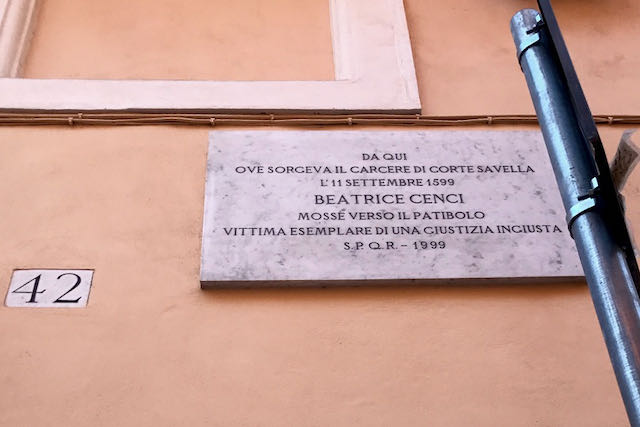 Beatrice Cenci - Victim of an unjust Justice, via Giulia, Rome.
Beatrice Cenci - Victim of an unjust Justice, via Giulia, Rome.Beatrice is buried high on the Gianicolo Hill in the lovely church of San Pietro in Montorio.
Il Cagliostro
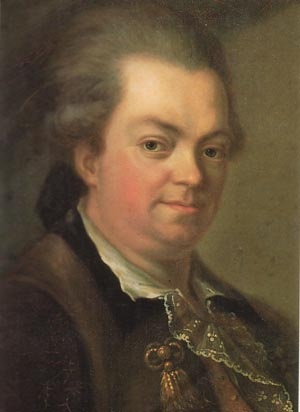 The fascinating life of Count Alessandro Di Cagliostro represents a very complex affair that history has not yet been able to fully reveal.
The fascinating life of Count Alessandro Di Cagliostro represents a very complex affair that history has not yet been able to fully reveal.Count Alessandro di Cagliostro (1743 - 1795) was the alias of the occultist and bonvivant Giuseppe Balsamo.
Cagliostro was born poor, but grew up to embrace a fascinating, if a bit illegal, life full of adventure and shenanigans.
He made his way into the royal courts of Europe, practicing dark arts and magic.
He became infamous for some of his misdeeds including a particularly shocking case of a stolen diamond necklace that involved Marie Antoinette.
Cagliostro was a mason, mystic, healer, and alchemist.
Sadly, he lived during the Inquisition in which people like him were often betrayed by their friends and relatives to curry favour with the Inquisitors.
And that's exactly what happened.
Possibly Cagliostro's wife was the one to betray him during Confession, but either way, on 27 December 1789 he was arrested and imprisoned in Castel Sant Angelo Rome.
He was sentenced to death, but his sentence was later reduced to life imprisonment.
He was moved to another prison where he eventually died.
Benvenuto Cellini
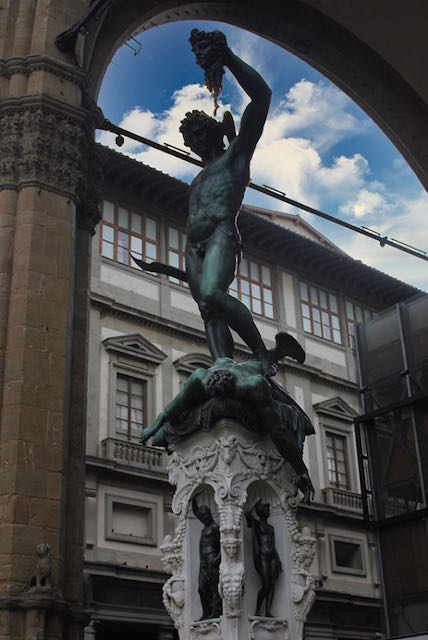 Benvenuto Cellini, Perseus with the Head of Medusa, bronze (Loggia dei Lanzi, Piazza della Signoria, Florence)
Benvenuto Cellini, Perseus with the Head of Medusa, bronze (Loggia dei Lanzi, Piazza della Signoria, Florence)Benvenuto Cellini (1500 – 1571) was an Italian goldsmith, sculptor, jeweller, poet, and artist.
He lived a very colourful life and his deeds/misdeeds almost overshadow his masterpieces.
One of Cellini's best-known works sits in Piazza della Signoria in Florence - Perseus with Medusa's head.
As a jeweler he was sometimes involved in making or fixing important pieces of nobles and popes.
At one point, he was falsely accused of stealing some jewels from the pope's tiara.
Nonetheless he was imprisoned in Castel Sant'Angelo.
He managed to escape but broke his leg in the process.
He was put back in prison but later pardoned.
Cellini would be accused of many things, most of them true (sodomy, murder, rabble-rousing.)
But he was in such favour with the Medici's and the French court that he outlived it all and died peacefully at the age of 71.
ONE OF THE MOST FASCINATING AUTOBIOGRAPHIES OF ALL TIME!
The autobiography of Benvenuto Cellini is considered by many to be one of the must fascinating of all time.
He basically chronicles his relatively long life and speaks matter-of-factly of his deeds and misdeeds including rape and murder.
Castel Sant Angelo Rome - museum today
After the unification of Italy in the late 19th century, Castel Sant’Angelo became a military barracks.
In 1901 it was converted to the Museo Nazionale di Castel Sant’Angelo.
Today, a visit will allow you to see all aspects of this monument's complex history - from the original Roman architecture when it was Hadrian's tomb, to war remnants like cannons and cannonballs, to Renaissance art.
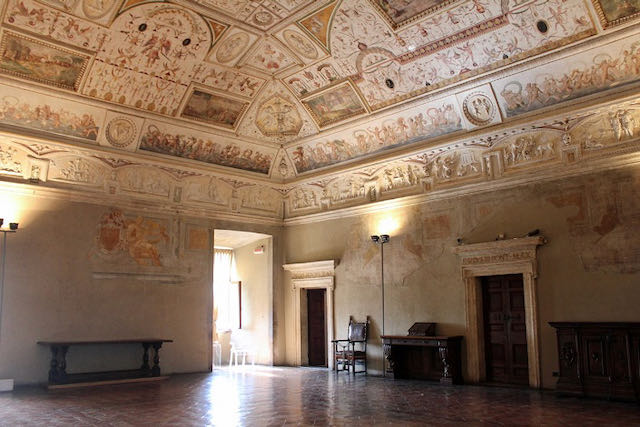 In the library of Castel Sant Angelo Rome, you will see gorgeous Renaissance-era grotesque art on the ceiling and along the top of the walls.
In the library of Castel Sant Angelo Rome, you will see gorgeous Renaissance-era grotesque art on the ceiling and along the top of the walls.Castel Sant Angelo Rome - plan and architecture
When Hadrian’s Mausoleum was built, it was the tallest building in Rome.
Like the building that inspired it, the mausoleum of Augustus, Hadrian’s mausoleum was also a decorated cylinder.
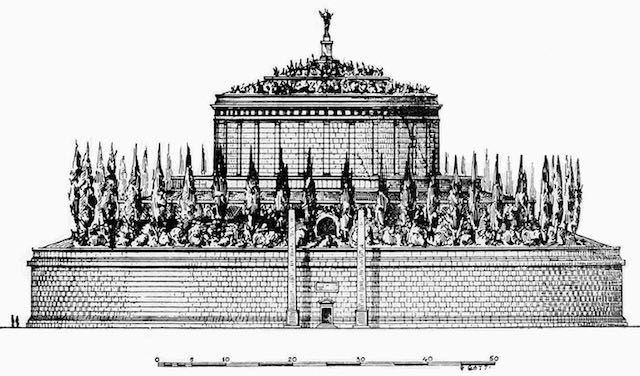 Hadrian's mausoleum was a pretty close copy of the mausoleum of Rome's first Emperor, Octavian Augustus. This rendering shows what Augustus' tomb might have looked like.
Hadrian's mausoleum was a pretty close copy of the mausoleum of Rome's first Emperor, Octavian Augustus. This rendering shows what Augustus' tomb might have looked like.It was topped with cypress trees and Hadrian as the sun god Helios driving a golden quadriga (4-horse chariot).
On all sides along the top there would have been statues of previous emperors.
Size of Castel Sant Angelo Rome
Because Castel Sant’Angelo looms so large, both literally and figuratively, over Rome, it boggles my mind that Augustus’ mausoleum is in fact LARGER than Castel Sant’Angelo.
Augustus’ mausoleum measured 90 m (295 ft) in diameter by 42 m (137 ft) in height.
Hadrian’s mausoleum was comprised of a square 89 meters (292 feet) wide base on a cylindrical colonnaded drum with a diameter of 64 meters (210 feet).
A wall surrounded the mausoleum.
The entry was through a large bronze gate flanked by two bronze peacocks.
You can see the peacocks in the new wing of the Vatican Museums (in the Pinecone courtyard you can see copies.)
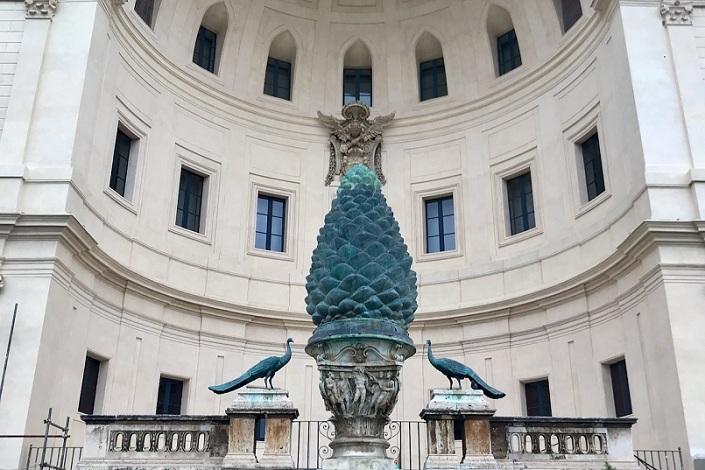 You can see copies of Hadrian's peacocks in the Pinecone Courtyard of the Vatican Museums.
You can see copies of Hadrian's peacocks in the Pinecone Courtyard of the Vatican Museums.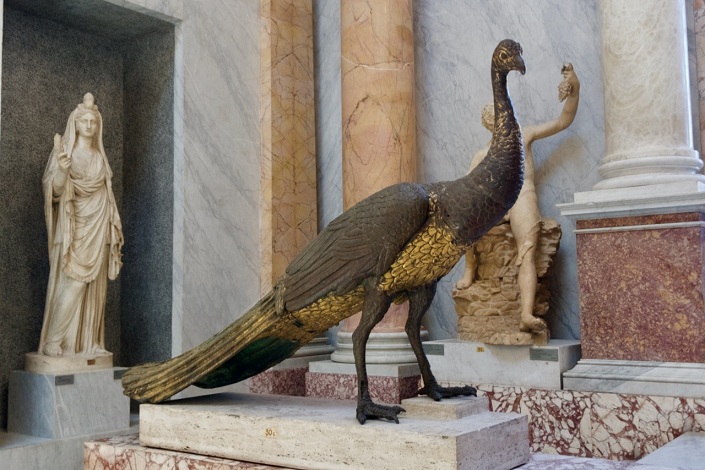 The original peacocks from Hadrian's tomb are in the New Wing of the Vatican Museums.
The original peacocks from Hadrian's tomb are in the New Wing of the Vatican Museums.The building was made of travertine and tufa using the opus caementicium pattern.
You can still see some of this stone today on the first levels.
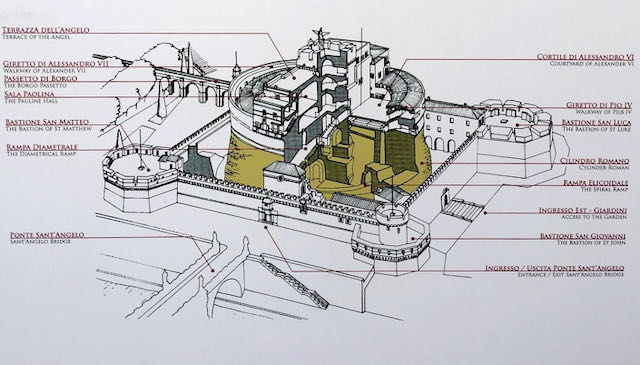 As you can see from this architectural plan of the levels of Castel Sant Angelo Rome, there is a lot to see inside. And it will give you a good sense of Rome's 2,000-year-old history.
As you can see from this architectural plan of the levels of Castel Sant Angelo Rome, there is a lot to see inside. And it will give you a good sense of Rome's 2,000-year-old history.There was a helicoid ramp inside that allowed access to the top.
That is the ramp you walk on today when you visit the inside of the castle.
And it’s the ramp you use to exit the monument.
As you exit, take a look at the little model of the original mausoleum.
The perfect 3-day itinerary in Rome
Trying to figure out how to organize your visit to Rome? I've got the perfect 3-day itinerary for first-time visitors (or those who have not been here in a while.) It works for a 2.5 day visit as well.
In my 3-day itinerary, you'll see all the major must-see Rome attractions like the Vatican, Colosseum, Trevi Fountain, Pantheon, Piazza Navona, Spanish Steps, and much more.
And if you have more time, or want suggestions for extra/other things to do, you'll find that there too.
Visit my page with the best 3-day itinerary in Rome for first-timers.
The Angel Bridge – Ponte Sant’Angelo
When Hadrian had his mausoleum built, he also ordered a bridge that would connect his mausoleum to the city on the other side of the Tiber.
That bridge still exists today even though it, too, has been changed a bit since its inception.
At the time of its creation, the bridge was called Pons Aelius (after Hadrian whose full name was Publius Aelius Hadrianus).
Once the mausoleum changed its use and name, the bridge followed suit and was also renamed to Ponte Sant’Angelo, or Angel Bridge.
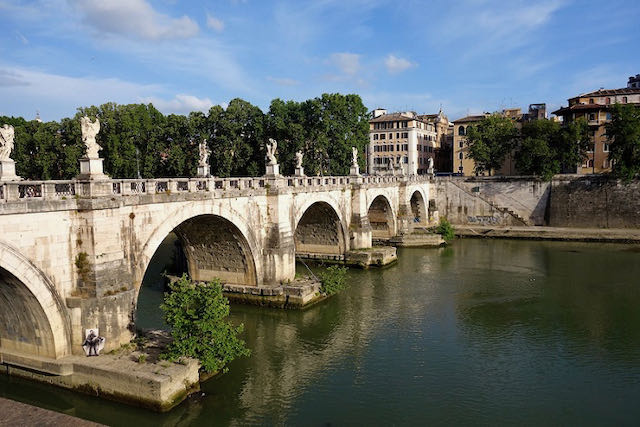 The Angel Bridge that leads to Castel Sant Angelo Rome is adorned with angels inspired by designs by Gian Lorenzo Bernini.
The Angel Bridge that leads to Castel Sant Angelo Rome is adorned with angels inspired by designs by Gian Lorenzo Bernini.The structure of the bridge is from ancient Rome whereas the beautiful 17th century angels that adorn the bridge were inspired by designs of Gian Lorenzo Bernini.
If you want to see the actual angels that Bernini made that did inspire the ones on the bridge, you can visit the church of Sant’Andrea delle Fratte.
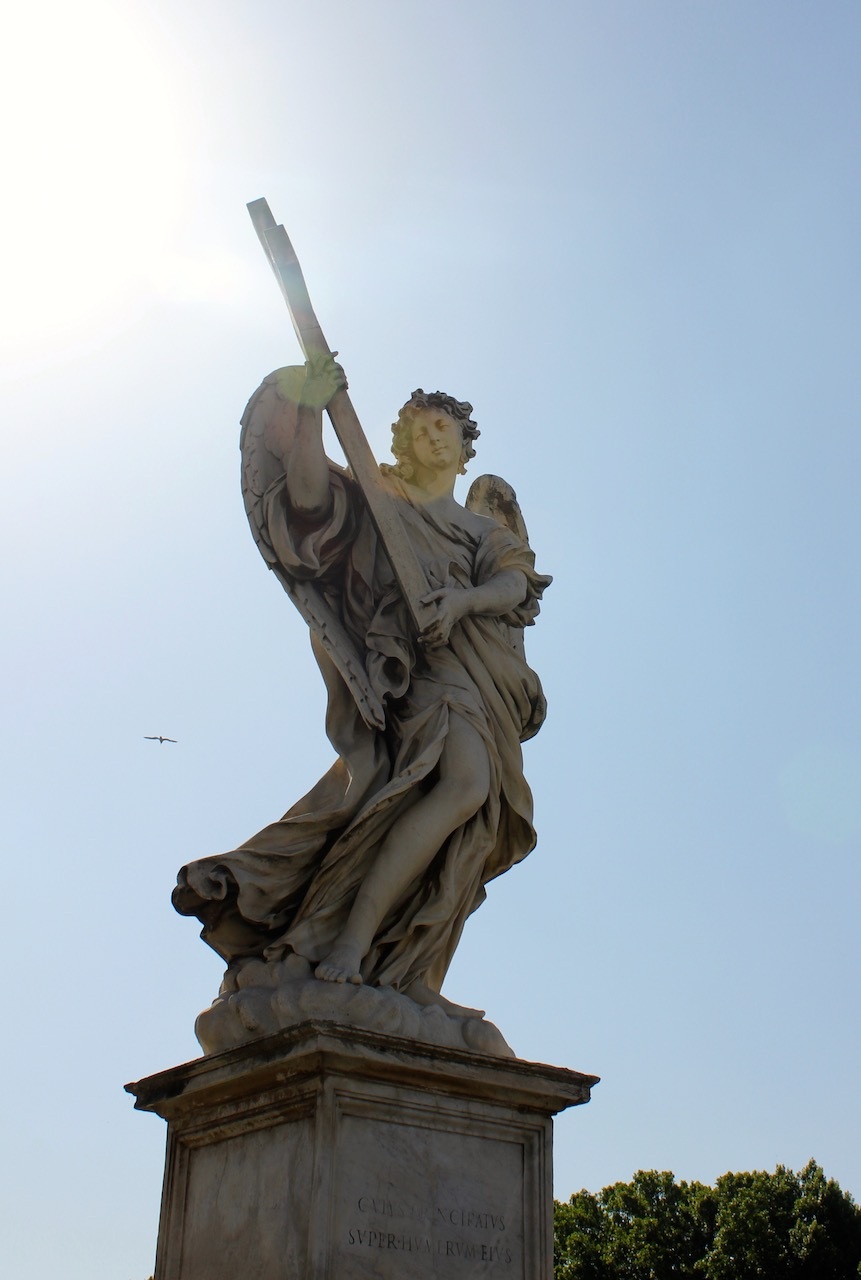 One of the angels on Ponte Sant'Angelo.
One of the angels on Ponte Sant'Angelo.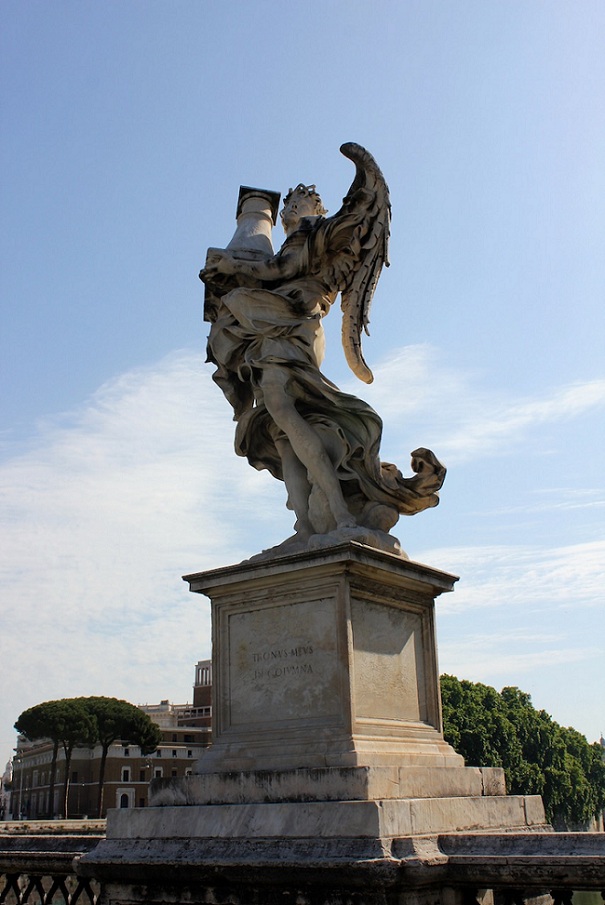 Another of the angels on Ponte Sant'Angelo.
Another of the angels on Ponte Sant'Angelo.In darker times, and before the angels you see today, Ponte Sant’Angelo was sometimes adorned by the severed heads of those who’d been executed at the castle.
Something right out of a horror movie but that’s the way it was!
The angels you see today hold various objects that symbolize the Passion of Christ.
The order is from Rome towards the castle.
Disclosure: If you make a purchase through a link on this page, I may receive a small commission - at no extra cost to you. Thank you for supporting my site!
Romewise's Top Travel Resources
Ready to book your trip to Rome? Take a look at these helpful links to companies we use and trust:
- Keep your travel spending simple with the Wise card, which removes all the worry about exchange rates and high transaction fees all over the world
- Search for and book your perfect accommodation
- Our complete guide to what to pack for Rome
- The number one travel accessory, a multi-point travel adapter and voltage converter
- Browse a huge range of tours in Rome and beyond
- Experience unique tours and special access to Rome's most popular sights
- Protect yourself with comprehensive travel insurance
Within this post there are some affiliate links for products and services. For more details about our affiliate policy click here.
Get your 100% free Rome trip planner now!
Simply sign-up today for our free newsletter and get the Romewise Quick Start guide to Rome:
We are committed to respecting your data. Click for our Privacy Policy.
Comments? Questions? Suggestions?
Please come over to the private Romewise Facebook group and join in the conversation.
You will often find me there, happy to answer your questions / comments!
You will also meet other Rome lovers and experts, too.
What are you waiting for?
- Romewise Home Page
- Castel Sant Angelo Rome


